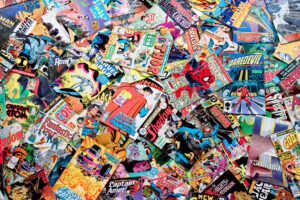Groo: The Hogs of Horder #1 (of 4) — Writers: Sergio Aragones and Mark Evanier; Art: Sergio Aragones
A new Groo mini-series is always a cause for celebration, and this one is no exception. Aragones and Evanier are always careful to provide thoughtful satire in with all the cheese dip and mendicant jokes, and here, while showing their bumbling hero destroying the economy of an entire country with a few ill-timed stumbles, they’re also laying the groundwork for one of the clearest explanations for our own Great Recession you’re likely to find anywhere (hint: it involves people being greedy, overconfident and stupid).
Ambush Bug: Year None #7 (of 6) — Writers: Keith Giffen and Robert Loren Fleming; Pencils: Giffen, Baltazar and Franco; Inks: Al Milgrom
More satire, but this one focuses on a much smaller target: the comics industry (specifically, DC comics). This is #7 of 6 because the sixth issue, due almost a year ago, never came out; rumor was that its Final Crisis topic, and snarky digs at Dan Didio, were deemed too negative, or disrespectful, or something, to be published (which is, of course, what the targets of effective satire always say). Since this “substitute” issue also has digs at those targets, it’s hard to know what to believe (one possibility: the original was even more savage than what’s here; another possibility: this whole thing has been an elaborate hoax; third possibility: a little from column A…), but in any event it’s nice for the Bug to get some closure. The more you follow mainstream superhero comics, and are a fan of the whole medium, the more you’ll appreciate the humor — clever in the writing, and equally so in the art — of this book.
Blackest Night #4 ( of 8 ) — Writer: Geoff Johns; Pencils: Ivan Ris; Inks: O’Clair Albert
Green Lantern #47 — Writer: Geoff Johns; Pencils: Doug Mahnke; Inks: Christian Alamy
Superman: Secret Origin #2 (of 6) — Writer: Geoff Johns; Pencils: Gary Franks; Inks: Jon Sibal
Geoff Johns continues to demonstrate why DC should be paying him tons of money: first, the Blackest Night juggernaut continues to roll along, as this halfway-point issue ups the ante by revealing what happens on Earth when those damn black rings hit 100%; meanwhile, Green Lantern focuses on the outer-space adventures of Hal Jordan, Sinestro and the other multi-hued ring-bearers as they fight one another and the main threat. All of this seems to be moving confidently and inexorably towards some actual, planned conclusion, one that presumably will leave fans both breathless and satisfied — no small thing, as followers of other company-wide crossovers can attest. Finally, over in Superman: Secret Origin we have a smooth retelling of the Superboy saga, traveling well-trod ground as it introduces the Legion of Super-Heroes, but doing it with careful attention to all the emotional buttons (Clark’s sense of isolation, and eventual delight at finding friends; Luthor’s misplaced superiority, which keeps him from being able to do the same), and the added advantage of Franks’ pretty, perfect-for-the-setting art. The whole package manages to keep the elements that worked in the past, while updating the story to appeal to modern readers, too — a trick just as difficult as managing a successful company crossover, and another reminder of why DC had better hope that Johns never gets unhappy or bored with his current job.
New Avengers #58 — Writer: Brian Michael Bendis; Pencils: Stuart Immonen; Inks: Wade von Grawbadger
Ultimate Avengers #3 — Writer: Mark Millar; Pencils: Calsos Pacheco; Inks: Danny Miki, Dexter Vines and Allen Martinez
Meanwhile, over at Marvel, their current multi-book crossover continues, as Luke Cage has a heart attack and gets captured, the Night Nurse shows why she’s not to be messed with, the repowered Hood comes back, Jonas Harrow and his power-dampener take center stage, and we’re told that the Avengers Have a Plan. This is just the kind of single-issue chapter of an ongoing soap opera that Bendis does well, and he and the art team deliver enough satisfying twists and character bits to keep readers coming back for more. Over in the Ultimate Universe, Millar and Pacheco (with a tag-team group of inkers, unfortunately) do the same thing with their (supposedly) more grown-up version of the group; it doesn’t have the sense of connectivity to a huge world that the mainstream Avengers does, but then it has the advantage of being able to throw any curve it wants at the readers, from the Red Skull being Captain America’s illegitimate son to the new Wasp casually killing the bad guys to Tony Stark’s older brother being even richer and more insufferable than he is. If Jeph Loeb did anything positive during his run on this franchise, it was to show us just how entertaining and addictive Millar can be, despite his various tics and occasionally head-scratching plotting.
Madame Xanadu #16 — Writer: Matt Wagner; Pencils: Amy Reeder Hadley; Inks: Richard Friend
Back to the regular team after six issues of Michael Wm. Kaluta, and it’s not the letdown we might have expected. Instead, it’s a good first chapter of a new story, focusing on an ordinary woman experiencing supernatural weirdness, and showcasing Hadley’s clean, attractive facial and figure compositions, and Wagner’s ease at building suspense out of the small everyday pieces of life, when they start to become… odd.
Stuff I read and liked enough to buy, but don’t have much to say about, so read previous reviews in the archives if you’re interested:
Detective Comics #858 — Writer: Greg Rucka; Art: J.H. Williams III
Justice Society of America #32 — Writers: Bill Willingham and Matthew Sturges; Art: Jesus Merino
Jack of Fables #39 — Writers: Bill Willingham and Matthew Sturges; Pencils: Russ Braun; Inks: Jose Marzan, Jr. and Andrew Pepoy
Astro City: Astra #2 (of 2) — Writer: Kurt Busiek; Art: Brent Anderson
Phil Mateer


